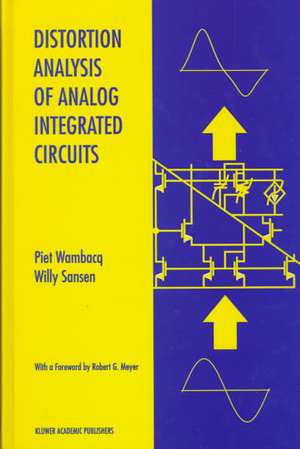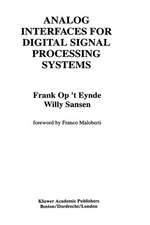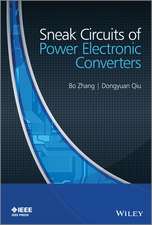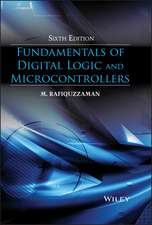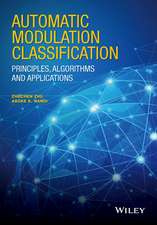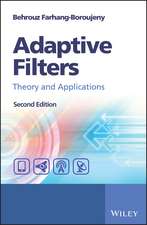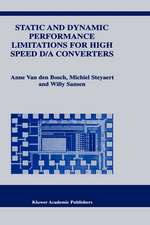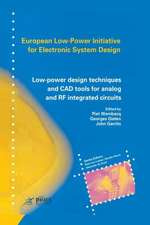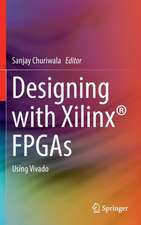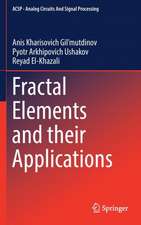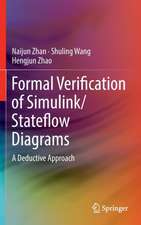Distortion Analysis of Analog Integrated Circuits: The Springer International Series in Engineering and Computer Science, cartea 451
Autor Piet Wambacq, Willy M.C. Sansenen Limba Engleză Hardback – 30 iun 1998
| Toate formatele și edițiile | Preț | Express |
|---|---|---|
| Paperback (1) | 2099.14 lei 6-8 săpt. | |
| Springer Us – 5 ian 2011 | 2099.14 lei 6-8 săpt. | |
| Hardback (1) | 2105.92 lei 6-8 săpt. | |
| Springer Us – 30 iun 1998 | 2105.92 lei 6-8 săpt. |
Din seria The Springer International Series in Engineering and Computer Science
- 24%
 Preț: 1041.98 lei
Preț: 1041.98 lei - 20%
 Preț: 643.50 lei
Preț: 643.50 lei - 18%
 Preț: 1225.62 lei
Preț: 1225.62 lei - 18%
 Preț: 965.02 lei
Preț: 965.02 lei - 20%
 Preț: 646.12 lei
Preț: 646.12 lei - 18%
 Preț: 948.79 lei
Preț: 948.79 lei - 20%
 Preț: 646.62 lei
Preț: 646.62 lei - 15%
 Preț: 637.46 lei
Preț: 637.46 lei - 20%
 Preț: 643.83 lei
Preț: 643.83 lei - 18%
 Preț: 949.23 lei
Preț: 949.23 lei - 20%
 Preț: 644.48 lei
Preț: 644.48 lei - 20%
 Preț: 994.92 lei
Preț: 994.92 lei - 20%
 Preț: 645.97 lei
Preț: 645.97 lei - 18%
 Preț: 946.87 lei
Preț: 946.87 lei - 20%
 Preț: 995.57 lei
Preț: 995.57 lei - 18%
 Preț: 956.99 lei
Preț: 956.99 lei - 20%
 Preț: 644.98 lei
Preț: 644.98 lei - 15%
 Preț: 649.54 lei
Preț: 649.54 lei - 18%
 Preț: 950.21 lei
Preț: 950.21 lei - 18%
 Preț: 1221.38 lei
Preț: 1221.38 lei - 18%
 Preț: 957.62 lei
Preț: 957.62 lei - 15%
 Preț: 643.99 lei
Preț: 643.99 lei - 18%
 Preț: 948.47 lei
Preț: 948.47 lei - 18%
 Preț: 947.35 lei
Preț: 947.35 lei - 20%
 Preț: 1284.65 lei
Preț: 1284.65 lei - 20%
 Preț: 1628.31 lei
Preț: 1628.31 lei - 20%
 Preț: 1285.78 lei
Preț: 1285.78 lei
Preț: 2105.92 lei
Preț vechi: 2568.20 lei
-18% Nou
Puncte Express: 3159
Preț estimativ în valută:
402.95€ • 420.76$ • 332.75£
402.95€ • 420.76$ • 332.75£
Carte tipărită la comandă
Livrare economică 15-29 aprilie
Preluare comenzi: 021 569.72.76
Specificații
ISBN-13: 9780792381860
ISBN-10: 0792381866
Pagini: 501
Ilustrații: XXIV, 501 p.
Dimensiuni: 155 x 235 x 33 mm
Greutate: 0.93 kg
Ediția:1998
Editura: Springer Us
Colecția Springer
Seria The Springer International Series in Engineering and Computer Science
Locul publicării:New York, NY, United States
ISBN-10: 0792381866
Pagini: 501
Ilustrații: XXIV, 501 p.
Dimensiuni: 155 x 235 x 33 mm
Greutate: 0.93 kg
Ediția:1998
Editura: Springer Us
Colecția Springer
Seria The Springer International Series in Engineering and Computer Science
Locul publicării:New York, NY, United States
Public țintă
ResearchCuprins
1 Introduction.- 2 Basic terminology.- 3 Description of nonlinearities in analog integrated circuits.- 4 Volterra series and their applications to analog integrated circuit design.- 5 Calculation of harmonics and intermodulation products.- 6 Silicon bipolar transistor models for distortion analysis.- 7 MOS transistor models for distortion analysis.- 8 Weakly nonlinear behavior of basic analog building blocks.- 9 Measurements of basic nonlinearities of transistors.- Appendices.- A Useful trigonometric relationships.- B Basics of Volterra series.- B.1 Introduction.- B.2 Volterra series representation of a system.- B.3 Second-order Volterra systems.- B.3.1 The second-order operator.- B.3.2 The second-order Volterra operator.- B.3.3 Second-order kernel symmetrization.- B.4 The second-order kernel transform.- B.4.1 The two-dimensional Fourier and Laplace transform.- B.4.2 Sinusoidal response of a second-order Volterra system.- B.4.3 Response of a second-order system to a sum of two sinusoids.- B.5 Higher-order Volterra systems.- B.5.4 The p-dimensional Laplace and Fourier transforms.- C Derivation of the method for the direct computation of nonlinear responses.- C.1 Setup of basic equations.- C.2 First-order responses.- C.3 Second-order responses.- C.4 Higher-order responses.- D Nonlinearity coefficients for the description of the Early effect.- E Relation between source-referred and bulk-referred nonlinearity coefficients of a MOS transistor.- F Derivatives of the drain current with an implicit saturation voltage.- F.2 First-order derivatives.- F.3 Higher-order derivatives.- G Derivation of the MOS drain current in the presence of velocity saturation.- G.1 Derivation of the drain current with the simple velocity-field models.- G.2 Derivation of the drain current with the more accurate velocity-field model.- G.2.1 The rigorous approach.- G.2.2 Approximate approach.
